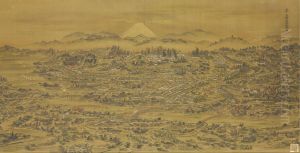Kuwagata Keisai Paintings
Kuwagata Keisai, whose real name was Kitao Masayoshi, was a Japanese ukiyo-e artist, painter, and book illustrator active during the late Edo period. He was born in 1764 in Edo (present-day Tokyo), Japan. Initially, he started his artistic career under the guidance of Kitao Shigemasa, from whom he inherited the Kitao name. He later studied under the influential ukiyo-e artist Katsukawa Shunsho, which led to his initial works being influenced by the Katsukawa school's style, characterized by the depiction of actors and beautiful women.
Keisai's body of work is notable for its diversity and innovation. He is particularly known for his unique style of 'simplified pictures' (ryakuga), which capture the essence of his subjects with minimal and often humorous strokes. This style is exemplified in his series 'Keisai's Pictures of One Hundred Children' and 'Simplified Lessons in Pictures', which illustrate a variety of subjects using simple, dynamic lines. These works highlight Keisai's ability to convey movement and character in a few deft strokes, a skill that made his instructional drawing books popular among the general public.
In addition to his simplified drawings, Keisai explored other genres, including landscapes and bird-and-flower paintings. He is credited with creating a series of prints called 'Keisai's Famous Views of the Eastern Capital', which depict various scenic spots in and around Edo. His landscapes often included famous places known for their historical or literary significance, and they reflect the contemporary interest in travel and tourism among the Japanese urban populace.
Keisai's artistic production also included 'Warrior Prints' (musha-e), which were images of historical and legendary Japanese warriors. This genre was less common among the ukiyo-e artists of his time, but Keisai managed to infuse his works with a distinct flair, often using the ryakuga technique to distill the essence of the warrior's character and actions.
Despite his contributions to Japanese art, Keisai was not as commercially successful as some of his contemporaries. Nevertheless, his innovative approaches to ukiyo-e and his instructional art books had a lasting impact on the development of Japanese art, influencing subsequent generations of artists. Keisai passed away in 1824, leaving behind a legacy that is appreciated for its originality and expressive quality.

